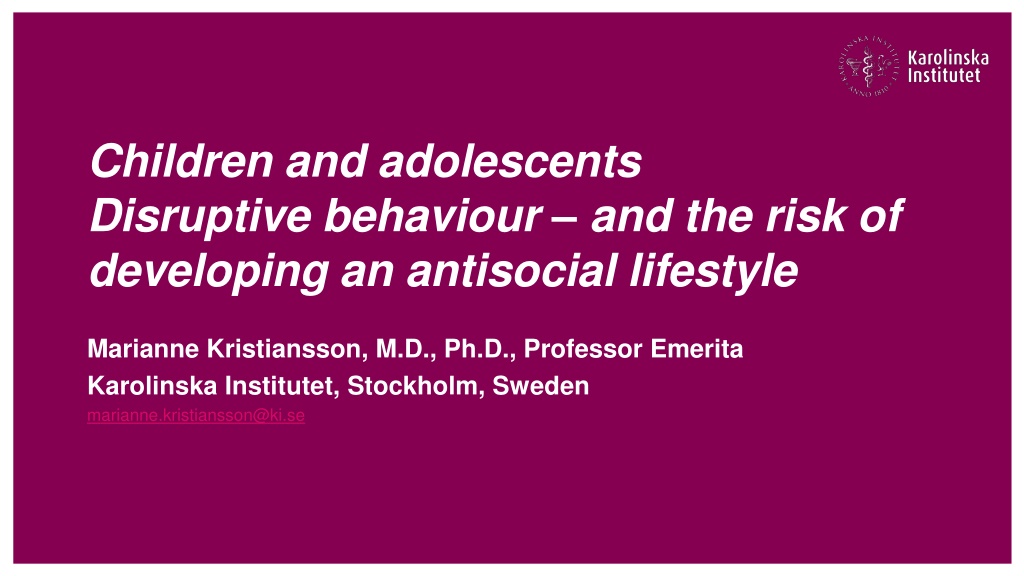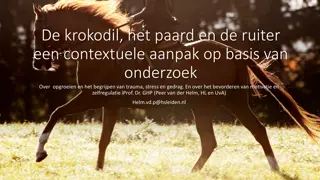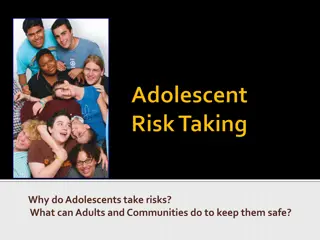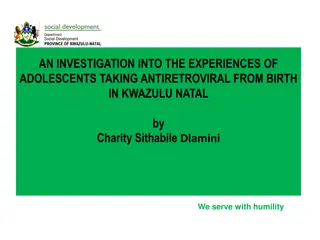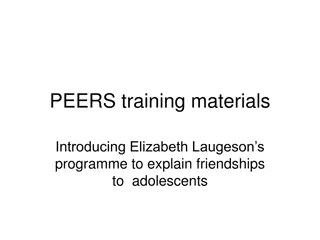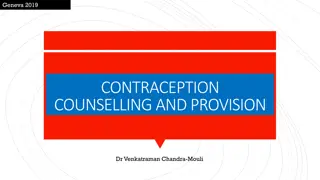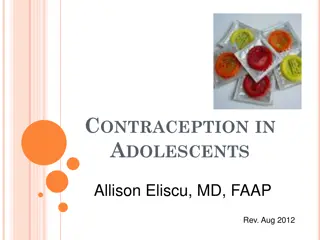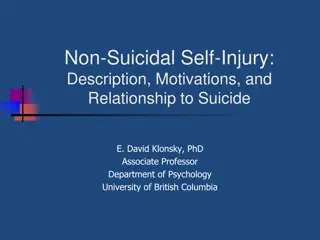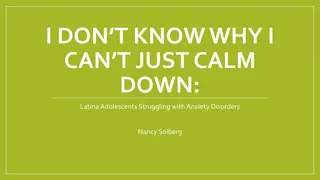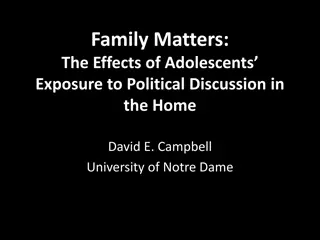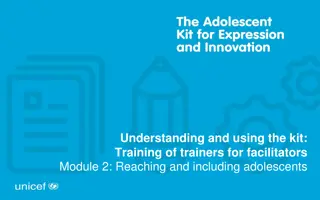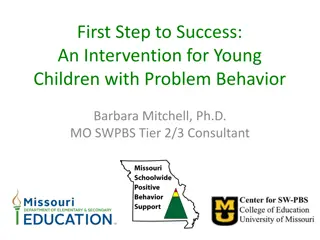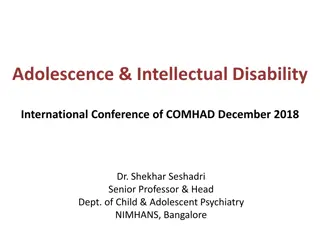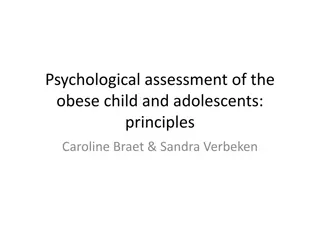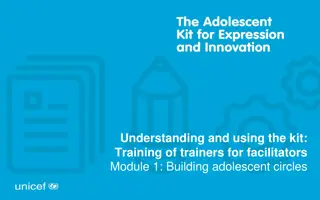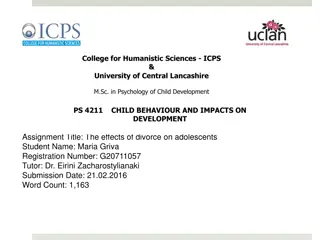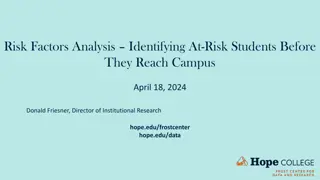Understanding Antisocial Behavior in Children and Adolescents: Risk Factors and Implications
Exploring the development of disruptive behaviors in children and adolescents, this content sheds light on the risk of evolving into an antisocial lifestyle. It discusses various factors such as early onset, organized crime influence, lack of support structures, and educational challenges. Additionally, it highlights key risk factors like family environment, peer influences, substance abuse, and past antisocial behavior. The concept of antisocial temperament involving impulsive tendencies, lack of empathy, cognitive deficits, and apathy is also addressed.
Download Presentation

Please find below an Image/Link to download the presentation.
The content on the website is provided AS IS for your information and personal use only. It may not be sold, licensed, or shared on other websites without obtaining consent from the author. Download presentation by click this link. If you encounter any issues during the download, it is possible that the publisher has removed the file from their server.
E N D
Presentation Transcript
Children and adolescents Disruptive behaviour and the risk of developing an antisocial lifestyle Marianne Kristiansson, M.D., Ph.D., Professor Emerita Karolinska Institutet, Stockholm, Sweden marianne.kristiansson@ki.se
Youth delinquency A problem? Yes and No
Many children exhibit minor antisocial acts but most do not continue!! Note children starting before the age of 13!!! Farrington and Loeber, 2000
What has changed? Organized crime can be an important factor! The amount of drugs Between 2014 and 2019 the production of drugs from South America doubled (World drug report, UN)
Social services and National Board of Institutional Care (SIS, Governmental agency) The Social Services Act measures mostly on a voluntary basis foster care homes, residential care homes LVU Care of Young Persons (Special Provisions) Act institution, foster care homes, residential care homes LSU Secure Youth Care Act institution no clear care chain!!!
What can you learn from Sweden? 1. 1. Sweden has been too late in detecting the inflow of organised crime and drugs as well as trafficking (children, women, sex, labour market) 2. 2. Sweden has been slow to react to disruptive behaviour in children and youths 3. 3. Lack of structure in the organisation for young persons with disruptive behaviour 4. 4. Lack of follow-up measures 5. 5. The educational system is not designed for vulnerable people 6. 6. Housing significant segregation
Risk factors for antisocial behaviour the big eight! Extremely well known! Andrews and Bonta Antisocial family lack of schooling and work Antisocial Peers Substance Abuse Disorder History of antisocial behaviour, lack of social network Antisocial attitudes Antisocial temperament
Antisocial temperament Impulsive behaviour Lack of empathy Cognitive reduced mentalisation Affective not caring
It takes a village to raise a child Kathrin Thomas, Headmistress Many different skills and functions need to be developed! Some need more support Preventive social investments school psychologist, school nurse, school doctor, school welfare officer physiotherapist, occupational therapist, speech therapist child and adolescent psychiatry, habilitation
Daniel is a 16-year-old boy who grew up in a family with five siblings. An older brother has been convicted of a crime, and a younger brother is taken into care with the support of LVU Care of Young Persons (Special Provisions) Act. A sister has been visiting BUP (barn- och ungdomspsykiatrin Child and adolescent psychiatry) for depression and anxiety. Until 8th grade, Daniel attended school regularly, but for a year or so, his school attendance has been a rare occurrence. When the teachers want to talk to him and his parents, he sometimes comes to school, and when he does come to school, he is rather pleasant and finds it easy to socialise with others. It is not believed that he uses drugs. For about 6 months, reports of concern have been received by the police; these have arrived several times a month. The police believe that he sells drugs in the town square and that he regularly meets people from a criminal network. The police also suspect that he sometimes handles weapons which he passes on to older criminals, but the police have not been able to prove this. On four occasions, he has been caught with cannabis and Tramadol in his possession. He states that the drugs belong to a friend. When the police talk to him, he mostly laughs off what is said and displays a lack of fear and concern. A year or so ago, he started a relationship with a girl from his class. Several friends of hers have said that he probably abuses his girlfriend, but she does not dare to report this. On a couple of occasions recently, the police have noted that he was driving with a criminal who is older than him and who lives in town. Case
What should be done? Is it too late? When should we have reacted?
Education Ritchie sj. Et al. How much does education improve intelligence? A meta-analysis. Psychological Science 2018;29(8) 1358- 1369 It is enormously important for the individual s development, good health and to ensure a safe life! The importance of a cognitively enriched environment for a child s development
Behaviours The brain controls the hand, but the hand can shape the brain!! The importance of forming new pathways in the brain!!! The brain works in networks and adapts to the environment Mental models become behaviours Through motor learning, we create more stable networks Repeat favourable things! Some things can be automated Behaviours that are learned and practised in the sociocultural context 21 september 2024 13
The brain and shared networks Language and use of tools! Tool use and language share, syntactic processing, and neural patterns Basal ganglia Thibault S et al (2021). Science https://doi.org/10.1126/science.abe0874 21 september 2024 14
Anxiety child and adolescent behaviour For what?
Emotional callousness Criminal activity ???? Basic emotions impulses to action Emotional learning Reason and emotions Slow and quick decisions Balance Amygdala, Insula and Frontal lobes
Risk assessment always probabilities Antisocial background for example in the family The environment can affect brain development (e.g., cognitive stimulation) Antisocial friends Antisocial temperament e.g. shortcomings with regard to impulse control Shortcomings with regard to education and work Abuse of drugs, alcohol and medicines Vulnerability to recruitment into criminal networks Lack of order in the local environment/neighbourhood many criminals Being involuntarily alone and alienated
Two types of emotional callousness Affective Excitement, brave, bold Extremely fearless No apparent anxiety Difficult dealing with guilt and responsibility A lack of care Own gain Verbal, rather pleasant Survivor Cognitive Does not understand the thinking and intentions of others Extremely sensitive to stress Autistic traits Lonely, isolated Odd forms of communication Secondary anxiety/depression 21 september 2024 18
Risk assessment of young people in general SAVRY Structured Assessment of Violence Risk in Youth Centrum f r psykiatriforskning (Centre for Psychiatry Research) Region Stockholm offers courses
In case of concern Talk to the child/adolescent Talk to the family Social services (if needed) Various special initiatives The police, in the case of an act that may be a criminal offence Student health BUP Barn- och ungdomspsykiatrin (Child and adolescent psychiatry)
The importance of being part of a group my group When are we going to become extremely concerned???? 1. Missing school a lot 2. Drugs own abuse and/or sale 3. Contact with criminals
Structured plan ???? Which concrete activities? * Social skills training CBT based programmes Support parents * Follow up revision?
Particularly vulnerable individuals Violence and crime in the family Mental and physical ill health Poverty Crime in the local area Deficiencies in language development
What is the most difficult? Especially in children and adolescents Discovering certain traits of the personality linked to the driving forces that govern the individual Every individual must be assessed in their environment!
Purpose Try to learn to distinguish between two groups I will present two boys completely different!!
Case A Anders is an 11-year-old boy, and his parents are clearly worried about him. He ignores what his parents say. At school, he bullies his classmates, often starts fights and shies away from planned interactions with teachers when his behaviour is up for discussion. He completely ignores the fact that because of his behaviour, he was not allowed to accompany the rest of the class on a school trip. He doesn t seem to care what others think, never feels shame, and shows no signs of remorse or guilt. However, some teachers find him quite charming, even if it is sometimes obvious that he is lying. He constantly teases his younger sister and laughs when she becomes upset. Recently, his parents found him in the garden standing on the cat. The cat screamed but Anders thought it was extremely funny.
Case B Erik is an 11-year-old boy. Both his parents and teachers noticed that he is very lonely and probably being bullied. He can sometimes stare a little strangely at others, but he rarely says anything. Sometimes he sits in the classroom and stares out the window for long periods of time and when this happens, it is almost impossible to get his attention. The parents state that he sits in his room, online, for many hours. He often talks about war and guns and knives. His parents have also found a knife under his bed.
Case A and Case B completely different individuals! Case A Possible incipient emotionally callous traits developing Case B Possible incipient autistic traits
Callous traits/Psychopathy Fearless! An extra dimension of personality Failure of capacity for guilt, responsibility, remorse, compassion, empathy ASSESSMENT OF EMOTIONS
Why do we have feelings? Basic emotions survival Impulses to action Fast Anger, fear, sadness, joy, disgust, surprise Emotions More tied to memories Mood More continuous state
Key concepts for capacity for serious violent behaviour Empathy Lack of impulse control
Lack of empathy different personality traits Emotionally callous traits/Psychopathic traits Autistic traits
EMPATHY different concepts Motor learning Cognitive don't understand but can care Affective understands but doesn t care
Uncaring/Emotionally callous traits/Autonomic nervous system/The body essential/Extremely fearless Deficiencies in emotional learning! Amygdala Emotionally callous traits
Pronounced emotional callousness May be present in both cases, but due to completely different mechanisms
Autistic traits Does not understand the thinking and intentions of others Own fantasy world! While fantasies prepare us for reality, there are also risks involved if they are not grounded on reality. Sometimes severe anxiety when facing adversity Concrete communication Sudden outbursts of aggression
Emotionally callous/pre-antisocial traits Extremely fearless Charming, manipulative Doesn't care emotionally callous Implied sadistic traits Two groups Impulsive Controlled
Case Daniel is a 16-year-old boy who grew up in a family with five siblings. An older brother has been convicted of a crime, and a younger brother is taken into care with the support of LVU Care of Young Persons (Special Provisions) Act. A sister has been visiting BUP (barn- och ungdomspsykiatrin Child and adolescent psychiatry) for depression and anxiety. Until 8th grade, Daniel attended school regularly, but for a year or so, his school attendance has been a rare occurrence. When the teachers want to talk to him and his parents, he sometimes comes to school, and when he does come to school, he is rather pleasant and finds it easy to socialise with others. It is not believed that he uses drugs. For about 6 months, reports of concern have been received by the police; these have arrived several times a month. The police believe that he sells drugs in the town square and that he regularly meets people from a criminal network. The police also suspect that he sometimes handles weapons which he passes on to older criminals, but the police have not been able to prove this. On four occasions, he has been caught with cannabis and Tramadol in his possession. He states that the drugs belong to a friend. When the police talk to him, he mostly laughs off what is said and displays a lack of fear and concern. A year or so ago, he started a relationship with a girl from his class. Several friends of hers have said that he probably abuses his girlfriend, but she does not dare to report this. On a couple of occasions recently, the police have noted that he was driving with a criminal who is older than him and who lives in town.
Erik, who you met earlier when he was 11 years old, is now 17 years old. He is in his first year of upper-secondary school. He is very talented. He has no friends at school. Others bully him somewhat, even though things did get better in upper-secondary school. It has been established by BUP that he has Asperger's, and he has a contact person for this. His best subject is history, especially military history. He is extremely interested in this subject and the different types of weapons used in various wars. You have heard! That there have been several reports of concern from the police to Social Services because they have seen Erik talking to a serious criminal who does not live in the same residential area as Erik and his parents. The police have understood that Erik has never really committed any crimes, but that he is interested in weapons. At school, strange drawings with weapons have been found, and another student says that it is Erik who has done the drawings. Case
How should we think now? And what should we do?
Acting alone Lonely, bullied dissatisfaction Psychiatric help needed sometimes Own world of thought Virtual world online Increasingly alienated and violated Hatred, Revenge communicating discontent Isolate themselves almost completely Trigger Thoughts become concrete action
Structured plan Daily monitoring school, drug monitoring, no antisocial peers Social skills training CBT based programmes Support parents * Follow up revise
All stakeholders The brain and the sociocultural context of the individual The brain is trained in different ways Learning from environment, beliefs, attitudes, values, moral concepts Every individual is unique!!! We must always see the individual in his/her context Faster action is needed by all those involved when there are signs of criminal development
